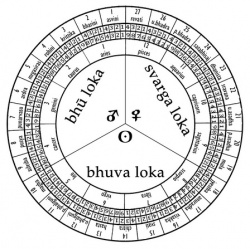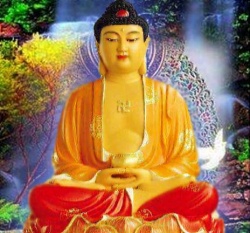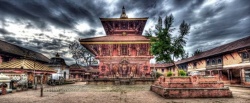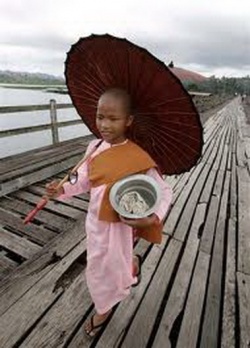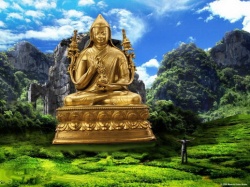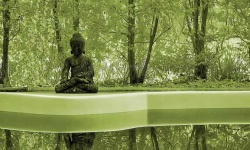Loka
Loka (Sanskrit: world, realm, abode, dimension, or plane of existence) from loc, “to shine, be bright, visible” — the universe or any particular division of it. A dimension of manifest existence; cosmic region.
Each loka reflects or involves a particular range of consciousness.
The most common division of the universe is the triloka, or three worlds (Bhuloka, Antarloka and Brahmaloka), each of which is divided into seven regions.
Corresponds to any of the 14 worlds (visible and invisible) inhabited by living beings.
In Hinduism, lokas refer to worlds, spheres or localities, roughly corresponding to the planes of nature in theosophy, but with significant differences. The names and number of lokas differ according to the sources.
The Pur€Šas give seven, while in Sš¥kHya and Ved€nta, there are eight, with differing names. There are seven lokas in the Pur€Šas:
1. Bhur-loka, the earth;
2. Bhuvar-loka, the space between earth and the sun;
3. Svar-loka, the space between the sun and the polestar;
4. Mahar-loka, the abode of Bhrigu;
5. Janar-loka, the abode of the sons of Brahma, like the Kum€ras;
6. Tapar-loka, the abode of the Vair€gis; and
7. Satya-loka or Brahma-loka, the abode of Brahm€.
The first three are destroyed at the end of a kalpa, while the last three continue for the entire manvantara.
The fourth one is not destroyed but is uninhabitable after the first three are destroyed. In S€‰khya and Ved€nta, the eight lokas are the following, whose names correspond to the beings residing therein:
1. Brahma-loka;
2. Pitri-loka;
3. Soma-loka;
4. Indra-loka;
5. Gandharva-loka;
6. R€kshasa-loka;
7. Yaka-loka; and
8. Pi€ca-loka.
Theosophical literature generally adopts the seven-fold Pur€Šic classification.
The Mahatma Letters to A. P. Sinnett, however, identifies mainly three lokas: kema-loka, or the world of desires, rupa-loka, the world of form, and arupa-loka, the formless world.
Kema-loka is the world where the desire-body of the deceased go.
The rupa and arupa-lokas correspond to devachan.
The letters also refer to the deva-loka, which is the abode of the various devas, some of which are more advanced than humans, while others are inferior.
Brahma- and Pitri-lokas are where the “creators” and “ancestors” of humanity are found.
These, including the deva-loka, are considered as states of consciousness rather than as “worlds.”
The lokas have matching talas or nether-worlds, also called “hells.” They are as follows:
Lokas Talas
1 Satya-loka Atala
2 Tapar-loka Vitala
3 Janar-loka Sutala
4 Mahar-loka Ras€tala
5 Svar-loka Talatala
6 Bhuvar-loka Mah€tala
7 Bh™r-loka P€t€la
Geoffrey Barborka writes that each world has a spiritual or consciousness aspect (loka) and a matter aspect (tala), like two sides of a coin. They should not be considered as 14 localities but just seven.
Neither should lokas be called heaven, and talas hell.
“The loka is representative of the evolution of spirit during the Ascending Arc, whereas the tala represents the evolution of matter on the Descending Arc.”
The lokas may also be considered as the “principle” side of a plane, while the talas are the element side (Divine Plan).
